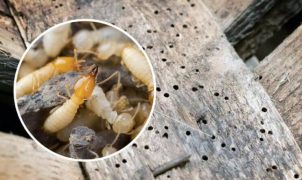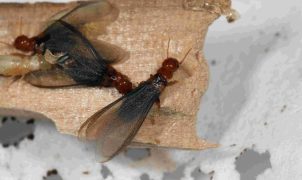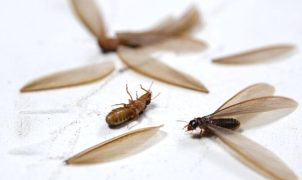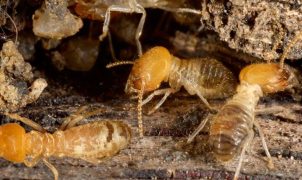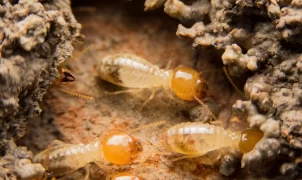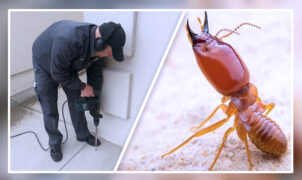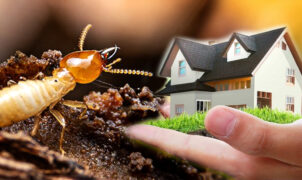Currently, the use of engineered wood for kitchen cabinets is very common. However, Vietnam is located in a tropical monsoon region with high humidity year-round, making it susceptible to termite infestation in engineered wood furniture. Moreover, kitchen cabinets are particularly vulnerable due to their high humidity environment and susceptibility to termite attacks. This article will provide effective methods for preventing and treating termite infestation.
1. Causes of Termite Infestation in Homes
Termites are insects closely related to ants, with soft bodies usually gray/brown or white – resembling “white ants”. Termites are harmful to construction works, even essential human belongings.Meanwhile, woodworms are hard-shelled insects, usually brown or black, with slightly gray hair. Woodworms specialize in damaging cereals such as rice, beans, and wood.The main food source for termites is cellulose – which is why untreated wood is prone to severe damage.Vietnam’s tropical monsoon climate, combined with high humidity in kitchen areas, creates favorable conditions for termite growth and development. Kitchen cabinets, often made of wood, provide an ideal food source for termites.
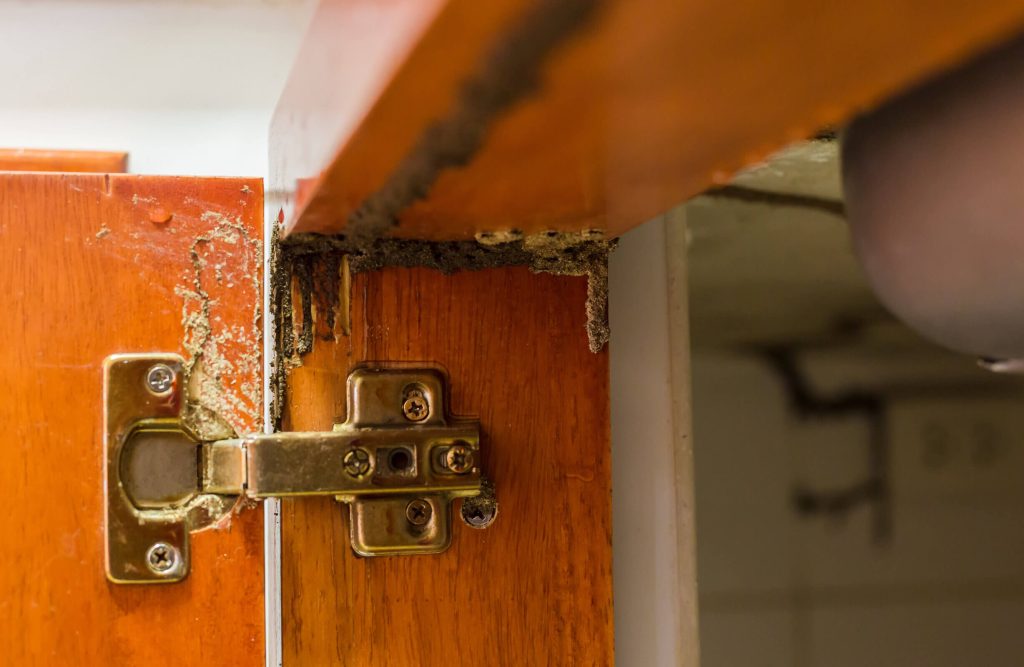
2. 6 Methods to Prevent Termite Infestation in Wood Kitchen Cabinets
“Prevention is better than cure” – Preventing termite infestation from the early stages will be more effective and avoid damage to your furniture. Especially in areas with a history of frequent termite attacks, these are tasks you should not overlook to protect your home from termite infestation.
2.1. Avoid Wood Contact with Water, Hot, and Humid Areas:
Wood exposed to water can easily become damp, affecting the quality, durability, and aesthetics of the wood. Therefore, you should limit water residue on wood surfaces and use a soft cloth to dry immediately after use.
2.2. Regularly Clean Wood Furniture for Effective Termite Prevention:
Use a soft, non-abrasive cloth to clean cabinets immediately after use to prevent moisture buildup and keep wood cabinets beautiful and new over time. Avoid using wet cloths to prevent paint discoloration and water absorption into the wood, which can cause cabinet damage. Avoid using cleaning chemicals to avoid damaging the cabinets.
2.3. Use High-Quality Wood to Help Prevent Termite Infestation:
Use wood from reputable brands that has been thoroughly treated to prevent termite infestation before being processed into furniture, such as moisture-resistant MDF, super moisture-resistant HDF, Picomat plastic, WPB plastic, etc. These types of cabinets are usually reasonably priced, durable, with many designs, high quality, and less susceptible to termites.
2.4. Apply Vecni Paint to Wood Surfaces to Prevent Termite Infestation:
Applying paint or vecni to wood surfaces will make them look newer and create a temporary protective layer for the wood to prevent termite infiltration. Typically, wooden items are prone to termite infestation after a period of use. Repainting not only makes the wood look newer but also protects it from termites.
2.5. Use Essential Oils to Prevent Termite Infestation:
Termites often like the smell of wood and moisture but dislike the smell of lemongrass essential oil. Lemongrass essential oil contains antibacterial agents such as citral and geraniol that help prevent termites. Moreover, lemongrass essential oil is extremely safe, so you can confidently use it in wooden cabinets to help prevent termite infestation.
2.6. Dig Trenches to Prevent Termite Infestation:
According to architect Truong Thanh Trung (T&T Architecture and Interior Design Consulting Company), if not handled properly from the beginning, the appearance of termites in a house is entirely possible. To ensure comprehensive termite prevention, attention should be paid to trenching from the foundation. In particular, digging trenches is considered the most effective method.
3. 8 Effective Methods for Treating Termite Infestation
Termite treatment involves eliminating termites that are causing damage to your furniture. This task should be done as soon as possible to minimize damage. After treating termites, you need to refer to the 6 methods for preventing termite infestation mentioned above to prevent termites from returning.
3.1. Expose Infested Items to Sunlight:
The best way to treat termites is to expose infested items to sunlight for 2-3 days. Termites usually prefer moist, moldy, and dark places, so exposing them to sunlight and drying them thoroughly is one of the most effective methods for termite treatment. However, this method can only be applied to loose furniture that has just been infested by termites.
3.2. Use Kerosene to Treat Termites:
Kerosene is a chemical commonly used to treat termites in folklore. When you detect wood infested with termites, apply kerosene directly to the termite holes and use a sprayer to spray directly into the cracks of kitchen cabinets, hinges, and doors… Doing this continuously for about half a month will treat termites effectively.
3.3. Use Boric Acid to Treat Termites:
Boric acid is a compound commonly found in antibacterial solutions – it is also a chemical that can be used to treat termites. You can use a pack of boric acid powder purchased from a chemical store, mix it with water, and then spray it in places where termites are present, effectively treating termites in wooden furniture.
3.4. Use Salt to Treat Termites:
In folklore, salt is often used to treat termites because this method is quite effective and safe. The treatment is very simple: sprinkle salt on the termite path or directly onto the termite nest, and the termites will move away on their own.
3.5. Use Vinegar and Lemon to Treat Termites:
Using white vinegar mixed with lemon juice to spray on termite nests or areas where termites appear is also an effective and safe method of termite treatment.
3.6. Use Lime to Treat Termites:
In folklore, people also often use lime to treat termites. There are two ways to use it: sprinkle lime directly into termite nests or mix lime with water and pour it into termite nests.
3.7. Use Cardboard to Lure Termites:
Termites often love paper and cardboard. You can use a piece of cardboard to lure them – when they come to eat the cardboard, take it away and burn it, then put another piece of cardboard on. Doing this several times will eliminate all termite nests.
3.8. Use Termite Bait Boxes and Insecticides for Termite Treatment:
If you have tried all the above methods but still cannot eliminate termites, then use termite bait boxes and termite insecticides – available at pest control stores. However, these termite insecticides are usually quite toxic and require careful use, so they are often not suitable for families with young children. You should research the chemicals and read the instructions carefully before using this method.
These are simple and easy-to-apply methods for termite prevention and treatment. If possible, you should prevent termite infestation before completing your home and putting it into use to achieve durability and beauty for your kitchen cabinets.
Cre: happynest

